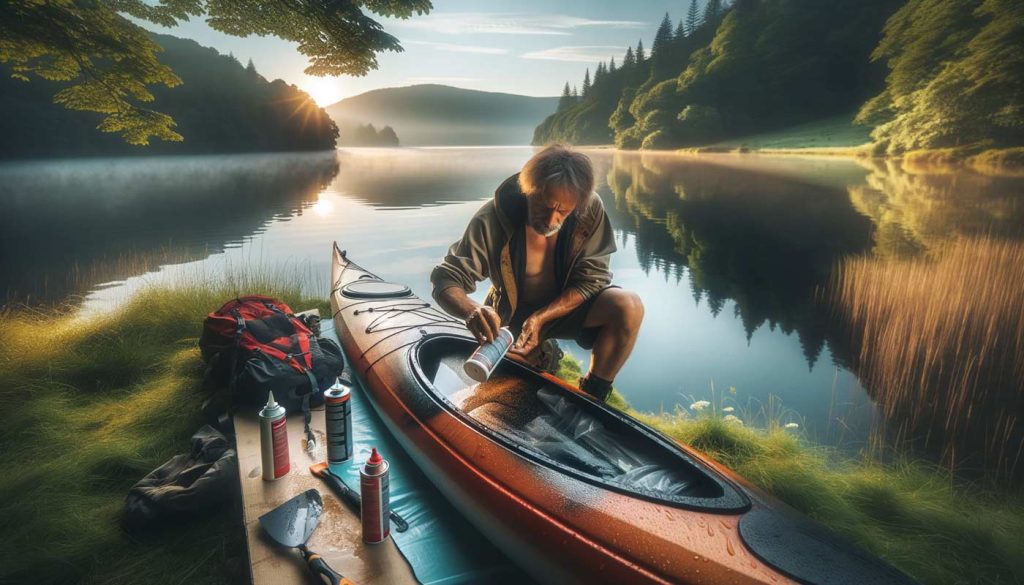Safe and reliable kayaking depend on maintaining your gear in good order. In particular, your kayak should undergo maintenance on a regular basis. Good kayak storage can help avoid future maintenance problems – store the kayak out of the sun. If you cover it with a tarp, ensure that the tarp is not in constant contact with the kayak – ensure a good airflow over the kayak so it stays dry. Use a cockpit cover when not paddling to protect the interior from UV radiation. In storage, use a mesh cockpit cover to keep critters out while allowing it to exchange air.
General Maintenance
Every time you paddle, you should take a good look at your kayak. If you find something that is not quite right, either fix it immediately, if possible, or note it for repair as soon as possible. Apply UV protectant to plastic deck hardware and rubber hatch covers every few months.
Annual Maintenance
- Inspect the hull and deck for gelcoat damage. If you find any damage, check that the damage does not go deeper into the composite layup. Repair any damage you find (see Hull repair).
- Inspect bulkheads. Make sure there are no cracks and that the sealant is in good repair.
- Inspect all deck lines. If you find any fraying or nicks in the lines, replace them.
- Inspect deck bungees. Replace any that show fraying or nicks. Make sure that knots in the bungie are not coming loose.
- Inspect toggles and lift handles. Pay particular attention to toggle lines for wear. Ensure that the handles are secure.
- Inspect the rudder or skeg. Make sure the control lines are in good condition and running free. Check that the rudder or skeg rotates freely on its axis – take it apart and clean it if not. Sand can get into the mechanism and add considerable friction. Tighten any bolts that may be loose.
- Inspect footpegs. Make sure the tracks are free of debris. Check that the rails are secured and tighten any bolts or screws that hold them in place. For rudder footpegs, check that the control lines and webbing are clean and in good condition; replace if damaged.
- Remove and inspect the rudder cables. Replace if damaged.
- Inspect the seat and back band or back rest. Ensure that the seat is held in place properly. Check the bolts on hanging seats and the webbing or lines that secure backs. Replace any lines or webbing that are damaged. If the seat is covered with fabric, repair or replace if damaged.
- Check seat, hip and thigh hook padding and re-glue or replace as necessary.
- Inspect hatch covers. Check for leaks and fix any seals that may leak. If the webbing that holds the hatch cover is damaged, replace. If the hatch covers are rubber or urethane (like VCP hatches), check for cracks and replace if necessary.
- Apply a UV protectant to all plastic deck hardware.
- Tighten all deck hardware screws and bolts.
Every Two or Three Years
UV damage will result in weakening of many components on a kayak, especially lines and rigging. As well, sand and grit get into lines and webbing and damage the fibers, weakening them considerably. The exact frequency of this maintenance will depend on your paddling pattern and locale. If you paddle in Australia, for example, where four season paddling and lots of strong sun is the norm, you may do this on a relatively short cycle. On the other hand, if you are a summer-only paddler living in a northerly location where there are many cloudy days, you can stretch this out considerably.
- Replace all deck lines.
- Replace all deck bungees
- Replace all deck webbing on hatch covers
- Replace toggle lines or lift handle webbing.
Don’t Forget the Other Gear
When you do annual maintenance on the kayak, take some time to check your other gear.
- PFD – Check for excessive sun fade, worn straps, stitching unraveling, compressed foam and so on. If it’s really bad, time for a new PFD.
- Roof racks – Check for rust and corrosion – apply a bit of WD-40 if required. Make sure the straps are in good shape and any lines used for tiedowns are in good shape.
- Tiedown point on your car – if you’ve rigged your own tiedown points, like loops of webbing that attach inside the trunk or engine compartment, check them out and replace the loops if required. Watch for rust near any wear points or holes you’ve drilled.
- Wetsuit, Drysuit and other paddling clothing. Check for wear and tear. Patch if required – Aquaseal is your friend.

